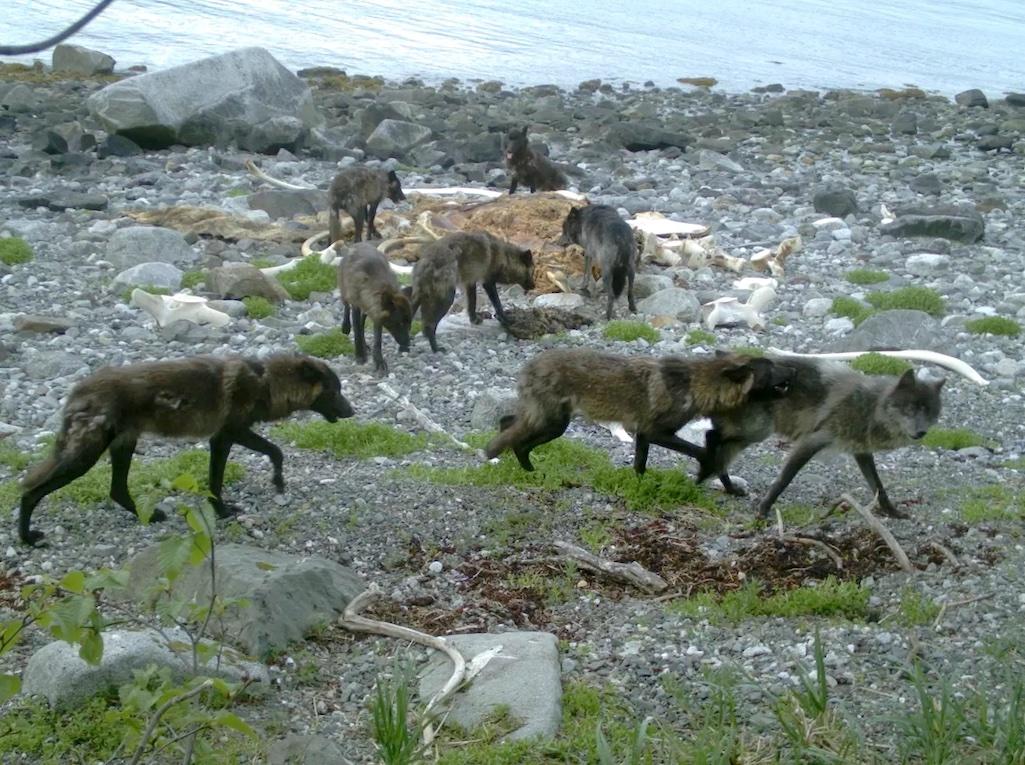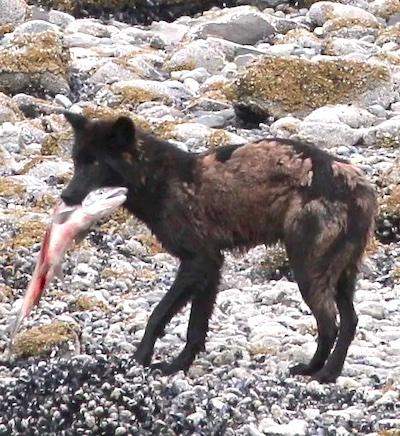
A pack of wolves feeding on the remains of a humpback whale, captured on remote camera/NPS, T. Lewis
Editor's note: The following article from Glacier Bay National Park and Preserve stems from multi-year research into the diets of wolves in the park. The principal researchers are Tania Lewis (NPS), Gretchen Roffler (ADF&G), Ellen Dymit and Taal Levi (Oregon State University).
Most wolves are dependent on large herbivore prey such as deer and moose to survive, but coastal wolves are opportunistic predators that have much more diverse diets, including seals, birds, salmon, shellfish, small mammals, and marine invertebrates. Glacier Bay is home to many wolf packs, but the size and distribution of these packs is not known. Wolves likely range from the mountains, where they hunt hoary marmots and mountain goats, to the river valleys where they hunt moose and salmon, and to the shoreline where they may feed on rodents, birds, shellfish, and marine mammals.
Glacier Bay National Park is investigating the importance of marine resources to wolves in the park. Sea otter has been detected as a primary prey species in Glacier Bay and surrounding areas where sea otter populations have been on the rise over the last several decades, providing an abundant and available food source for wolves. Are the rising sea otter numbers in Glacier Bay influencing the number of wolves on the shoreline? Are wolves mainly scavenging sea otters or actively hunting them? And if wolves are indeed hunting sea otters, does this predation affect sea otter numbers and distribution?
In addition to understanding the predator-prey relationship across the terrestrial and marine ecosystems, researchers seek to identify shoreline areas critical to wolves during denning and pup rearing. The Glacier Bay shoreline has experienced increasing visitation over the past 20 years. Expanding recreational use along its shorelines can have negative impacts on wildlife that utilize these ecosystems. Wolves can be extremely sensitive to disturbance, especially during pup rearing. Managers hope to identify shoreline areas that are important to wolves for feeding and reproduction so these areas can be protected from unnecessary disturbance.

Wolf eating salmon in Glacier Bay/NPS, D. Morda
Methods
Researchers determine what wolves are eating along the shoreline of Glacier Bay by walking the shoreline and collecting wolf scat and prey remains. Scat samples are then sent to a lab for analysis. This project expands on work of collaborators from Alaska Department of Fish and Game and Oregon State University using fecal DNA meta-barcoding to assess wolf diet. This detailed analysis identifies individual prey species found in scat and a relative proportion of each prey item, as well as identifies individual wolves to look at dietary differences between individuals.
In addition to scat collection, researchers can identify individual wolves using direct observations and remote cameras to gain insights on general areas of activity, den and rendezvous sites, pack ranges, and number of pups per year.
Results
A recent publication from collaborators found that from 2015 to 2021 on Pleasant Island just outside of the parks southern boundary the primary prey of wolves switched from deer to sea otters. During this time deer on the island were effectively eliminated by wolf predation while the proportion of sea otter in the pack’s diet rose from 21 to 68 percent. The diet of wolves at the southeastern mouth of Glacier Bay (Gustavus forelands) by contrast was largely comprised of moose (30 percent) but as well as sea otters (13 percent). Wolf scats sampled in a limited effort in northern Glacier Bay found diets comprised mostly of sea otters (28 percent), salmon (13 percent) and other fish (20 percent).
To further explore the diets of wolf packs in northern Glacier Bay, field crews in 2022 collected 183 canine scats across the shoreline of Glacier Bay and in the national preserve at the mouth of the Alsek River. The samples are currently at the lab being analyzed. Three wolf packs were observed in addition to the Gustavus pack being monitored by ADF&G. One pack seen multiple times ranged from Geikie Inlet to Blue Mouse Cove and had two pups. And a second pack seen once in Queen Inlet had three pups. A third pack in the Sandy Cove area was observed throughout the summer on remote cameras with five pups.


